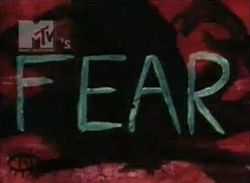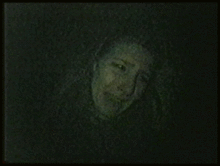Fear (TV series)
| Fear | |
|---|---|
 Show logo | |
| Format |
Reality Paranormal |
| Created by |
Martin Kunert Eric Manes |
| Country of origin | United States |
| Original language(s) | English |
| No. of seasons | 2 |
| No. of episodes | 16 |
| Production | |
| Executive producer(s) | George Verschoor |
| Running time | 43 minutes |
| Broadcast | |
| Original channel | MTV |
| Picture format | 480i (SDTV) |
| Original run | 2000 – 2002 |
| Chronology | |
| Followed by | MTV's Inside Fear (2001) |
| Related shows | Celebrity Paranormal Project (2006) |
| External links | |
| Website | |
Fear (promoted as MTV Music Television's Fear) is an American paranormal reality television series that originally aired from 2000 to 2002 on MTV. The program follows a group of five or more contestants being left at an allegedly haunted location and led them on a series of dares over two nights to explore and confirm whether or not the place is haunted. The show was created by Martin Kunert and Eric Manes. The pilot episode was Co-Executive Produced and directed by George Verschoor. The series aired the first two episodes in a pilot run, which received outstanding reviews and a full season was ordered.[citation needed] After eight more episodes, another season was ordered. The second season ended after 6 episodes aired. The series was not cancelled due to a lack of interest (the show was the second most popular on MTV at the time of its cancellation), but due to the high cost of producing each episode. A DVD, MTV's Inside Fear, was released on November 6, 2001.[1]
Fear was named #6 on Entertainment Weekly's "15 Taboo-Breaking TV Moments."[2]
The show brought several innovations to the reality show genre, including having contestants film their own experience as no video crew followed them into the 'haunted' locations, use of night vision cameras, and use of body mounted cameras to have contestants film their own close-ups.
Rules

Contestants were led by guides to the haunted area. They were then instructed to remove their blindfolds after a predetermined amount of time, allowing the guides to slip out unseen. The area where they are taken is known as the 'safe house', which is usually a large room somewhere within the haunted location where no hauntings are reported to have taken place. This location serves as the group's base and is the only part of the haunted location with lighting. Every member of the group chooses a color at random from a predefined list. During daylight hours, the group is allowed to sleep and eat, as dares only take place at night. Once night arrives, a computer terminal will usually pick one or two colors and assign a dare. This computer also provides the group with background information about the area. A member of the group, not assigned to the current dare, provides instructions from the computer via two-way radios.[1]
Each contestant is given the option, at any time during the dare, to abort. However, doing so will cause the contestant to forfeit their share of the winnings, and they will be required to leave the group. Another contestant will then be chosen by the computer to complete the dare. After two nights, any contestants remaining in the game will be directed to the location of their monetary prize, and each would collect $5,000 (in the pilot episode, the survivors only received $3,000 each).[1]
The dares themselves ranged in difficulty, often starting out easy and close to the safe house, eventually getting more difficult and further from the group's base. While most relied on simple observation (radio silence, EMF Detector), some of the dares relied on specific re-enactments of haunting events, and a few even dabbled in occult or paranormal possession (séance, automatic drawing, spirit channeling). For a complete list of dares, see Dares of MTV's Fear. [1]
Locations
The locations shown in the show usually had their name changed to protect their location from vandals and show fanatics. However, some of the places allowed their name to be used, and some of the fans of the show used the Internet to piece together potential matches for the locations used in the show. The locations used in the show were:
Season 1 (2000-2001)
- Episode 1 – West Virginia State Penitentiary
- Episode 2 – St. Agnes Hospital for the Chronically Ill* (Real Location: Fairfield State Hospital, Connecticut)
- Episode 3 – Duggan Brothers Cement Factory* (Real Location: Ideal Cement Company, 6411 Ideal Cement Rd., Castle Hayne, North Carolina)
- Episode 4 – Hopkins Military Academy* (Real Location: Augusta Military Academy, Virginia)
- Episode 5 – Camp Spirit Lake* (Real Location: Camp NoBeBoSco, Hardwick Township, New Jersey)
- Episode 6 – Buck Hill Inn
- Episode 7 – Eastern State Penitentiary
- Episode 8 – USS Hornet
- Episode 9 – Fort Gaines
- Episode 10 – La Guerre Plantation* (Real Location: Desert Plantation, Louisiana)
Season 2 (2001-2002)
- Episode 1 – Mina Dos Estrellas: Pt.1
- Episode 2 – Mina Dos Estrellas: Pt.2
- Episode 3 – Hacienda Tabi
- Episode 4 – Ki Sugar Mill* (Real location Haʻikū Sugar Mill in Haʻi kū, Maui, Hawaii)
- Episode 5 – Serenity Lake Sanitorium* (Real location King Edward Sanatorium in Padova City, Tranquille, British Columbia., Canada)
- Episode 6 – Boettger Brewery* (Real Location: Lemp Brewery, St. Louis, Missouri)
(* denotes locations where names are not the actual names of the location)
Music
The hard rock band Godsmack's song "Voodoo" was used as the theme song. For much of the second season, the song "First Day of Nowhere" by Sinisstar was used in the end credits.
Influence
- Psychic Carla Baron appeared in all of the original episodes (except for the 2 pilot specials - West Virginia State Penitentiary + St. Agnes Hospital.) Carla Baron went on to a very prolific television career - starring in her own reality series, "Haunting Evidence" for TruTV (formally Court TV) as a genuine psychic profiler on cold case crime scenes. Carla Baron has also appeared in multiple other television programs since Fear as a gifted psychic/ medium/ psychic profiler - "Psychic Detectives" (Court TV pilot), "Dead Famous" (Biography Channel), ABC Primetime (still airing in syndication on WE Channel), and most recently "MysteryQuest" (History Channel) and "Psychic Hollywood: The Search For Truth" (E! Entertainment).
- The storytelling and camera techniques which Kunert and Manes innovated for this series became the basis for their film Voices of Iraq.
- The show has been recreated in almost every aspect in VH1's Celebrity Paranormal Project.
- SyFy's channel's Stranded which premieres on February 27, 2013.
See also
- Celebrity Paranormal Project
- Dares of MTV's Fear
- Eric Manes
- Martin Kunert
- George Verschoor
- MTV
- Paranormal television
References
External links
- Official website
- Fear at the Internet Movie Database
- Inside Fear at the Internet Movie Database
- Film Threat article
- J.Son Dinant cast member of Fear on MTV
- Ideal Cement Factory Abandoned But Not Forgotten
| ||||||||||||||||||||